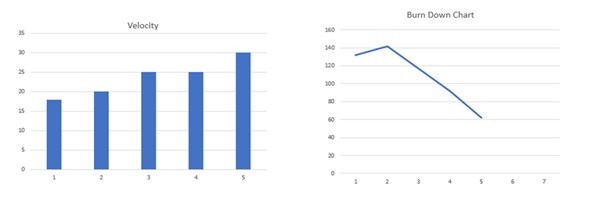PMI-ACP Practice Questions #112
Which of the following might clarify the burn-up observed after the second iteration in the burndown chart?

A. The team’s velocity unexpectedly dropped, leading to a backlog increase.
B. A large number of incomplete user stories from Iteration 1 were carried over, affecting the burndown.
C. The team had a deployment rollback, requiring them to redo previously completed work.
D. More work than the velocity of Iteration 2 was added as new scope to the release backlog during Iteration 2
Analysis
In this scenario, the burndown chart shows a burn-up after the second iteration, which means the remaining work increased instead of decreasing. Normally, a burndown chart should show a downward trend as work is completed. A burn-up typically happens when new work is added, previously completed work needs to be redone, or re-estimation of effort occurs.
Looking at the velocity chart, the team’s velocity is either stable or increasing, meaning they are delivering work at a reasonable pace. The burndown burn-up must therefore be related to an increase in work rather than a decrease in performance.
Analysis of Options
A: The team’s velocity unexpectedly dropped, leading to a backlog increase.
A drop in velocity would slow down progress, causing a flat line in the burndown chart, not a burn-up. A burn-up happens when remaining work increases, which is not directly caused by a drop in velocity. Since the velocity chart does not indicate a drop, this is not the correct explanation.
B: A large number of incomplete user stories from Iteration 1 were carried over, affecting the burndown.
Carrying over incomplete user stories does not increase total scope—it simply means work is being continued in a later iteration. The burndown chart tracks remaining work, not where the work is placed in iterations. If anything, carrying over unfinished work would maintain a steady burndown trend rather than causing a burn-up. This option does not provide a valid reason for the increase in remaining work.
C: The team had a deployment rollback, requiring them to redo previously completed work.
A rollback could require rework, which might increase remaining work, leading to a burn-up. However, the option does not specify if this rework was substantial enough to exceed the velocity of the iteration. While a rollback could contribute to the burn-up, it does not fully explain why the remaining work increased. There is a stronger option that more clearly aligns with what is seen in the burndown chart.
D: More work than the velocity of Iteration 2 was added as new scope to the release backlog during Iteration 2.
Adding more work than was completed in the sprint results in a net increase in total remaining work, causing a burn-up in the burndown chart. This aligns with Agile principles—if new scope is introduced and it exceeds the team’s delivery capacity, the backlog size increases, leading to an upward movement in the burndown chart. Since the question asks what “clarifies” the burn-up, this explanation is the most accurate.
Conclusion
The best answer is Option D: More work than the velocity of Iteration 2 was added as new scope to the release backlog during Iteration 2.
This option correctly explains why the burndown chart showed a burn-up. The issue was not a slowdown in delivery or spillover of work, but rather additional scope being added beyond what the team could complete, increasing the total remaining work. This aligns with Agile principles, emphasizing the impact of scope changes on tracking progress.
PMI – ACP Exam Content Outline Mapping
| Domain | Task |
| Delivery | Manage Agile Metrics |
Topics Covered:
- Understanding burndown and burn-up trends
- Managing Agile metrics and interpreting burndown charts
- Impact of scope changes on backlog and sprint tracking
- Relationship between velocity and remaining work
- Agile planning and scope management during iterations
If you’re preparing for the PMI Agile Certified Practitioner (PMI-ACP)® Exam, we highly recommend enrolling in our PMI-ACP® Exam Prep Program. Designed to provide a comprehensive Agile learning experience, this program not only helps you ace the PMI-ACP® exam but also enhances your Agile mindset, leadership skills, and ability to deliver value-driven projects. Ensure exam success and career growth with our expert-led, structured preparation program tailored for Agile professionals.